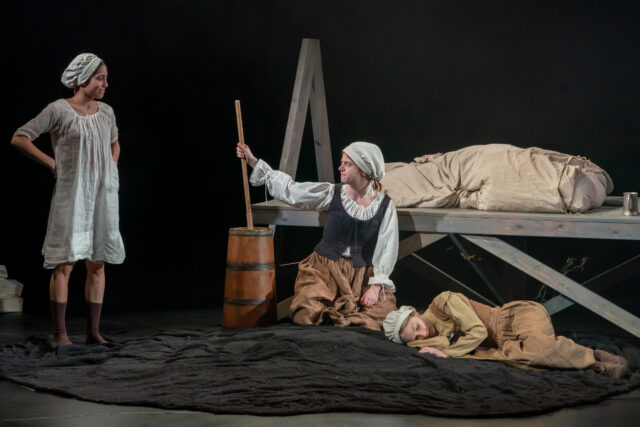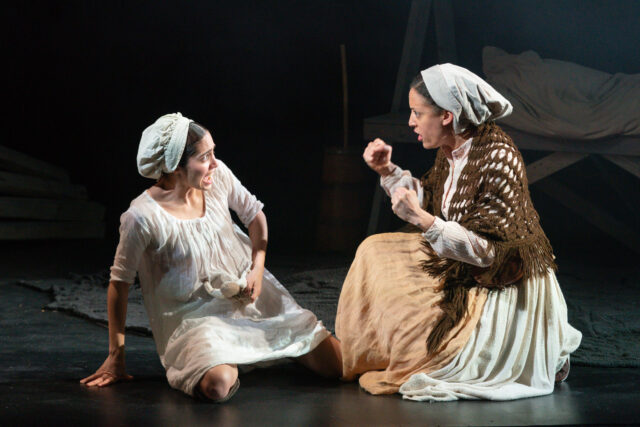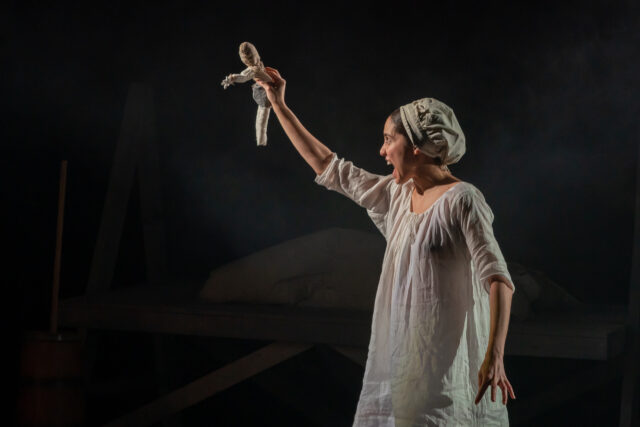
Betty Parris (Sharlene Cruz), Abigail Williams (Susannah Perkins), and Mercy Lewis (Tavi Gevinson) get ready for another day of drudgery in The Good John Proctor (photo by Ashley Garrett)
THE GOOD JOHN PROCTOR
Connelly Theater
220 East Fourth St. between Aves. A & B
Tuesday – Saturday through April 1, $55-$85
bedlam.org
Arthur Miller’s 1953 The Crucible, the semifictionalized story of the 1692–93 Salem witch trials that was also an allegory about the House Un-American Activities Committee hearings and the McCarthyism of the late 1940s and early 1950s, centers around what happened after a group of young girls are spied dancing naked in the woods of a Puritan town. Among those involved were John Proctor, a prominent landowner who was ultimately accused of witchcraft, along with his third wife. Court records referred to him as “Goodman Proctor,” while a local petition testified that “they lived [a] Christian life in their family and were ever ready to help such as stood in need of their help.”
Talene Monahon’s The Good John Proctor, which opened this afternoon at the Connelly Theater on the Lower East Side from the city-based Bedlam company, is a decidedly feminist exploration of what might have occurred leading up to that evening in the woods, ultimately resulting in the witch trials and the death of twenty-five people. It’s telling that despite the title, John Proctor never appears in the play, and that irony grows when it is revealed just what Proctor did.
The Good John Proctor begins with nine-year old Betty Parris (Sharlene Cruz) and eleven-year-old Abigail Williams (Susannah Perkins) in their shared makeshift wooden bed. Betty, whose father is a minister, tells her best friend and cousin about a dream she had in which she flew over the forbidden woods. Abby advises that she should keep that dream a secret for fear of what others might think. “I wasn’t on a pole or a stick or anything or a broom!” Betty argues. “Did you feel wicked?” Abby asks. “I felt amazing,” Betty responds.
The world of the play is exclusively the world of the girls, described in their language (complete with some purposeful anachronisms). Neither adults nor men appear, yet the narrative is utterly convincing. References to both class and gender are subtle, clear, or sly, never heavy-handed. The cousins like to play-act as king and peasant, emphasizing the hierarchical division in the town. Foul-mouthed fourteen-year-old Mercy Lewis (Tavi Gevinson) stops by to gossip, drink cider, and rail against sin and Satan; her words are the window into the social and religious constructs of Salem. “There is wickedness everywhere,” Mercy, who is a servant for George Borroughs, another minister, proclaims. “I actually can’t believe how wicked this town has become.”

Betty Parris (Sharlene Cruz) is frightened by Mary Warren (Brittany K. Allen) in Bedlam production at the Connelly (photo by Ashley Garrett)
Soon Abby is at work serving John Proctor, while Betty plays with her rag doll, an alter ego that she has named Bangwell Put. Betty is surprised when a stranger, eighteen-year-old Mary Warren (Brittany K. Allen), shows up, listening to the birds sing, talking about looking for “something beautiful,” and wanting to fly through the woods.
The girls seem almost feral; mothers are dead or too depressed to care. Shortly after menstruating for the first time — she has no idea why she has bled, having never been taught about what a period is — Abby gets promoted, spending more time with John Proctor, much to the dismay of his jealous wife, Elizabeth. Meanwhile, Mercy continues to spread rumors and Mary gets closer to Betty as the girls consider taking their chances and heading into the woods.
Miller wrote in his notebook, “It has got to be basically Proctor’s story.” While Monahon (Jane Anger, or . . . , How to Load a Musket) fills the play with references to such other historically documented figures as the Putnams, Giles Corey, and the Goodwin sisters, we only meet the four “afflicted” girls. But The Good John Proctor is not just about this quartet; while Miller’s play was a parable about McCarthy’s obsession with the Red Scare, Monahon’s is about the plight of women from biblical times to the present day.
Betty, Abby, Mercy, and Mary are uneducated children whose feminine desires are considered sinful and blasphemous. Blood flows throughout the play, almost exclusively related to childbirth, from Betty’s horrific memories of her mother’s miscarriage (she has no idea what it actually was) to Abby’s menstruation, from Mary miming cutting the umbilical cord when they pretend Betty has given birth to Bangwell Put to Betty getting whipped for saying a bad word. “You might wake up one day and everything is red,” Mercy tells Abby, which recalls the game Abby played with Betty when Abby showed off her nonexistent royal robe. “It’s so big and red!” Betty shouted with glee. “Yes, yes it is red. The reddest robe in all the land,” Abby proudly declared.
The name Bangwell Put itself is a reference to a real rag doll a relative made for five-year-old blind girl Clarissa Field in 1770 in Northampton, Massachusetts. Clarissa kept the doll until her death in her eighties; it is believed to be the oldest extant rag doll in America, so it represents the struggle and survival of women over the centuries.

Betty (Sharlene Cruz) holds Bangwell Put aloft in The Good John Proctor (photo by Ashley Garrett)
In a sly comment on the dominance of men in the Bible, the name of Betty’s goat is Abraham, the father of Judaism; Betty wants to use the goat as a donkey she rides into town on, evoking how Jesus entered Jerusalem.
The cast is exceptional, with Perkins (The Low Road, The Wolves) portraying Abby with a delightful sense of wonder; Cruz (Sanctuary City, Mac Beth) appealing as the serious Betty; Gevinson (This Is Our Youth, Moscow Moscow Moscow Moscow Moscow Moscow), who played Mary in Ivo van Hove’s 2016 Broadway adaptation of The Crucible, appropriately dour as the ever-suspicious Mercy, and Allen (Human Resources, Redwood) infusing Mary with a captivating mystery. As a unit, they conjure various stages of a young girl on her way through adolescence to womanhood.
Directed by Caitlin Sullivan (Ohio, Panopticon) with a sure hand, the play does get a bit repetitive, even at only ninety-five minutes, but the staging, with dark, atmospheric lighting by Isabella Byrd, eerie sound by Lee Kinney, and effective period costumes by Phuong Nguyen, puts you right in the middle of 1691 Salem, especially when the girls finally enter the woods. Bedlam has previously put its mark on plays based on Jane Austen’s Persuasion and Sense and Sensibility in addition to George Bernard Shaw’s Saint Joan and Pygmalion, Henrik Ibsen’s Hedda Gabler, and the Chekhov-Shakespeare mashup Uncle Romeo Vanya Juliet; in 2019 the troupe presented its version of The Crucible. With The Good John Proctor, they have successfully silenced the men, taking back the story from Miller and McCarthy, letting us hear the female voices that have so long been muted, to better understand what witchery is really about.